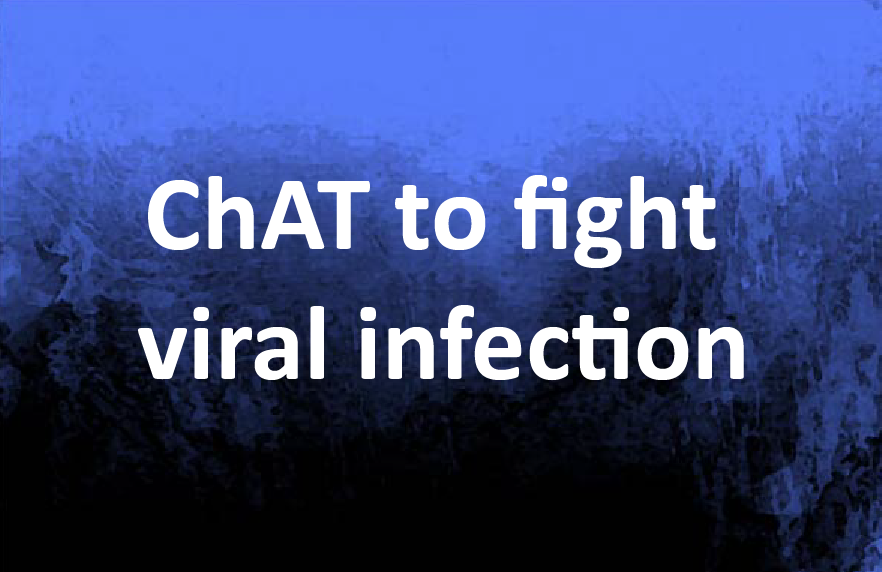ChAT to fight viral infection
Say ‘cholinergic’ and most biologists will think of the autonomic nervous system and acetylcholine’s role as a neurotransmitter. But do you know that T and B cells, macrophages and dendritic cells all express most of the components needed to run a functional cholinergic system? In this month’s blog, we’ll look at the work of Cox et al., who describe a cholinergic mechanism that helps T cells fight viral infections.
A well-studied role as a neurotransmitter
Acetylcholine (ACh) is a neurotransmitter, a chemical messenger released by nerve cells to communicate to other cells (neurons, muscle cells, and gland cells). As the first discovered and most abundant neurotransmitter, ACh’s contributions to the running of the central and peripheral nervous system have been well-studied. ACh is produced by the enzyme choline acetyltransferase (ChAT), using acetyl coenzyme A (acetyl CoA) and dietary choline as substrates. By binding to a nicotinic or muscarinic receptor on an adjoining cell, acetylcholine activates the receptor, ultimately enabling the continuation of a nerve impulse, the movement of a muscle, or other responses.
What about other cholinergic systems?
Although mostly thought of solely as a neurotransmitter, there is a history of research addressing the possible existence of non-neuronal cholinergic systems, and increasing evidence suggest that this is indeed the case. Here we’ll look at the recent work by Cox et al., who reveal how immune cells use ACh to help fight off viral infection. Now wouldn’t it be interesting if the immune and nervous systems talked the same language?
Let’s ChAT about immune cells expressing ChAT
Curious about why a population of immune cells (T and B cells) expresses ChAT (the enzyme that catalyzes the rate-limiting step of ACh production) (1), Cox et al. set out to investigate. Using a reporter mouse expressing green fluorescent protein (GFP) under the control of the ChAT promoter (ChAT-GFP), the researchers infected the mice with one of two strains of lymphocytic choriomeningitis mammarenavirus (LCMV): the Armstrong strain (LCMV-Arm), which is cleared rapidly, or the Cl-13 strain, which causes a chronic infection.
ChAT in T cells is triggered by viral signals
The acute infection with LCMV-Arm induced a significant increase in Chat-GFP expression in both CD4+ and CD8+ T cells, but expression rapidly declined after clearance. Conversely, Chat-GFP expression was retained in T cells during chronic LCMV infection. This finding suggests that the expression of ChAT in T cells is triggered by viral infection.
ChAT expression is induced by IL-21 follow infection
Viral infections promote the production of various proinflammatory cytokines, which influence the induction, differentiation, maintenance, and function of T cells. To determine whether cytokine(s) are involved in ChAT induction, the team stimulated Chat-GFP T cells in vitro with an LCMV epitope and several cytokines. Of those tested, ChAT expression was only induced by IL-21, which is normally produced by CD4 T cells during chronic infection. This finding was confirmed in vivo: mice in which the IL21 receptor gene was ablated failed to control chronic LCMV infection, and the same was true for mice with selective genetic loss of ChAT specifically within T cells. This reveals that ChAT expression in T cells is required during LCMV chronic infection.
ChAT in T cells promotes T cell tissue entry
Immunocompetent cells must penetrate the vascular wall and then migrate into the inflammatory tissue. When the authors studied the infected tissues, they realized that the loss of IL-21 signaling led to fewer CD8+ T cells in LCMV-infected tissues, compromising infection clearance. These findings suggest that the presence of ChAT in T cells promotes T cell tissue infiltration, but how?
Vasodilation by ACh helps T cells migrate into tissues
Vasodilation is critical for immune responses, and ACh signaling is known to induce vasodilation: even if at homeostasis only 1% of T cells express ChAT, depletion of ChAT in these cells is known to dramatically raise blood pressure in mice. The authors hypothesized that infection could induce an increase of ChAT in T cells and that this could lead to vasodilation, slowing blood flow enough to assist T cells traveling in the blood to migrate into the tissue. Indeed, LCMV-induced blood vessel dilation in the liver was lost in mice lacking T cell-expressed ChAT, and drug-induced vasorelaxation allowed those mice lacking ChAT-expressing T cells or IL-21 to regain control of chronic LCMV infection.
ChATing in the same language
Those thought-leaders that first proposed a connection between the brain and the immune system were widely dismissed, with their theory described as “folklore” in a 1985 editorial published in The New England Journal of Medicine (2). However, physicians now well recognize that the brain and immune system work together to protect us from illness. For example, cholinergic nerves innervate the bone marrow (3) and thymus (4) to mediate the control of lymphopoiesis, and the innervation of lymph nodes and lymphoid organs by the sympathetic autonomic nervous system (5) is a direct link between neural pathways and the peripheral immune system.
If the nervous and immune systems speak the same cholinergic language, theories of a linked immune-nervous system will be less easily dismissed as unconventional fits. And we’ll be watching this with interest!
References:
(1) Kawashima K, Fujii T. The lymphocytic cholinergic system and its contribution to the regulation of immune activity. Life Sci., 2003
(2) M. Angell, Disease As A Reflection Of The Psyche. New England Journal of Medicine, 1985
(3) Artico M, et al., Noradrenergic and cholinergic innervation of the bone marrow, Int Journ Mol Med, 2002
(4) Fatani JA, et al., Parasympatheticinnervation of the thymus: a histochemical and immunocytochemi-cal study. J Anat, 1986
(5) Mignini F, et al., Autonomic innervation of immune organs and neuroimmune modulation. Auton Autacoid Pharmacol, 2003




